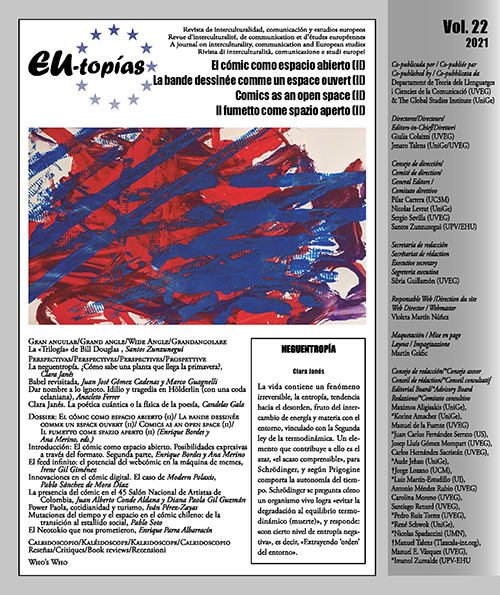The Neguentropy. How does a plant know that Spring is coming?
DOI:
https://doi.org/10.7203/eutopias.22.22923Keywords:
Schrödinger, Prigogine, entropy, thermodynamics, time, randomness, disorder, matter, energy. Abstract
Abstract
Life contains an irreversible phenomenon, entropy, a tendency towards disorder, result of the interchange of energy and matter with the environment, linked to the second law of Thermodynamics. One element that contributes such process is chance, «the understandable perhaps», for Schrödinger, involving the autonomy of time according to Prigogine. Schrödinger wonders how a living organism manages to «prevent thermodynamic equilibrium from degrading (death)», and answers: «with a certain level of negative entropy», that is, «By extracting ‘order’ from the environment».
 Downloads
Downloads
 References
References
Götschl, Johann (ed.). Erwin Schrödinger’s World wiew. The Dynamics of knowledge and Reality. Dordrecht, Boston y Londres: Kluver Achademic Publishers, 1992.
Hörz, Herbert. «Determinination and self organisation: Erwin Schrödinger’s views on chance», en Götschl, Johann (ed.). Erwin Schrödinger’s World wiew. The Dynamics of knowledge and Reality. Dordrecht, Boston y Londres: Kluver Achademic Publishers, 1992.
Prigogine, Ilia. Poésie an 2000. Quatorzieme biennale de poésie. Palais des Congres, Liege, du 30 aut au 3 septembre, 1984, Maison Internationale de la Poésie.
— El nacimiento del tiempo. Barcelona: Tusquets,1993.
— ¿Tan solo una ilusión?. Barcelona: Tusquets, 2004.
Prigogine, Ilia y Stengers, Isabelle. La nueva alianza. Metamorfosis de la ciencia. Madrid: Alianza Editorial, 1994.
Rupert Riedl. «Schrödinger’s negentropy concept and biology» en Götschl, Johann (ed.). Erwin Schrödinger’s World wiew. The Dynamics of knowledge and Reality. Dordrecht, Boston y Londres: Kluver Achademic Publishers, 1992.
Sánchez Ron, José Manuel. Albert Einstein. Su vida y su obra. Madrid: Crítica y Fundación BBVA, 2015.
Schrödinger, Erwin. ¿Qué es una ley de la naturaleza? México: Fondo de Cultura Económica, 1975.
— Mente y Materia, traducción de Jorge Wagensberg, Barcelona: Tusquets, 1990.
— ¿Qué es la vida?, traducción de Ricarrdo Guerrero, Barcelona: Tusquets, 2011.
— Was ist Materie?, Originaltonaufnahmen, 86 minuten, c+p 2002/2007 supposé Köln ISBN 978-3-932513-30-5 LC 10439.
Downloads
Published
How to Cite
-
Abstract475
-
PDF (Español)626
Issue
Section
License
![]()
The authors conserve the copyright. All content published in EU-topías. Journal of interculturality, Communication, and European Studies are subject to the license Creative Commons Attribution-NonCommercial-ShareAlike 4.0 license. The full text of the license can be found at <http://creativecommons.org/licenses/by-nc-sa/4.0>
They may be copied, used, disseminated, transmitted and publicly displayed, provided that:
- The authorship and original source of the publication is cited (journal, publisher and URL of the work).
- They are not used for commercial purposes.
- The existence and specifications of this license of use are mentioned.
It is the responsibility of the authors to obtain the necessary permissions for images that are subject to copyright.



